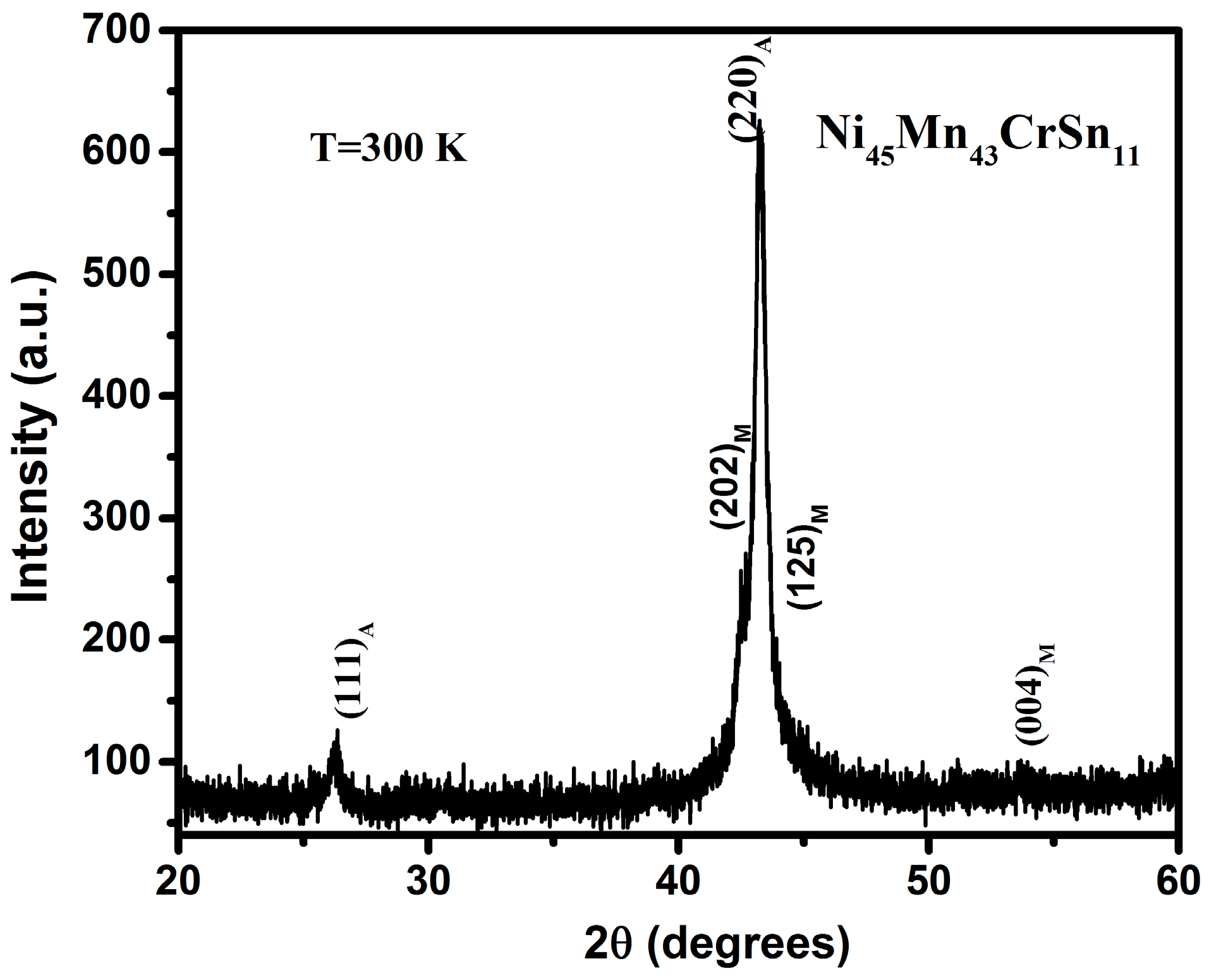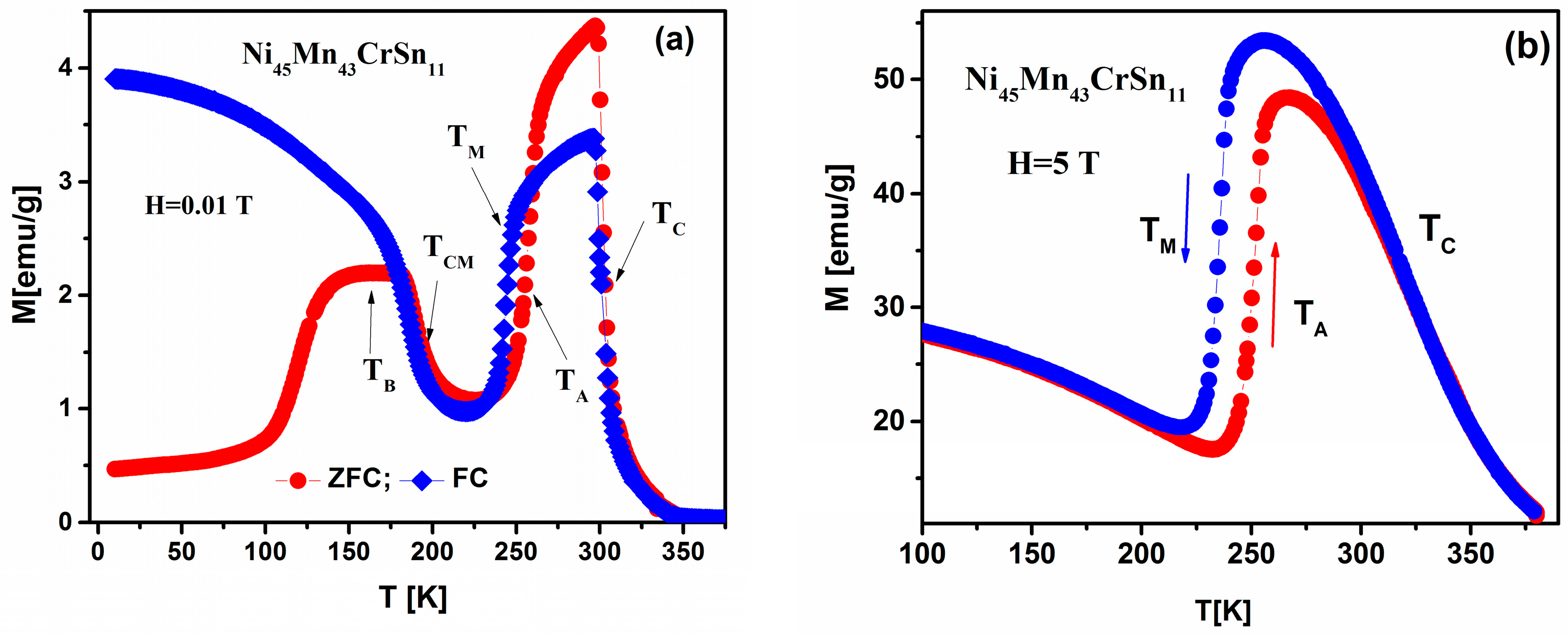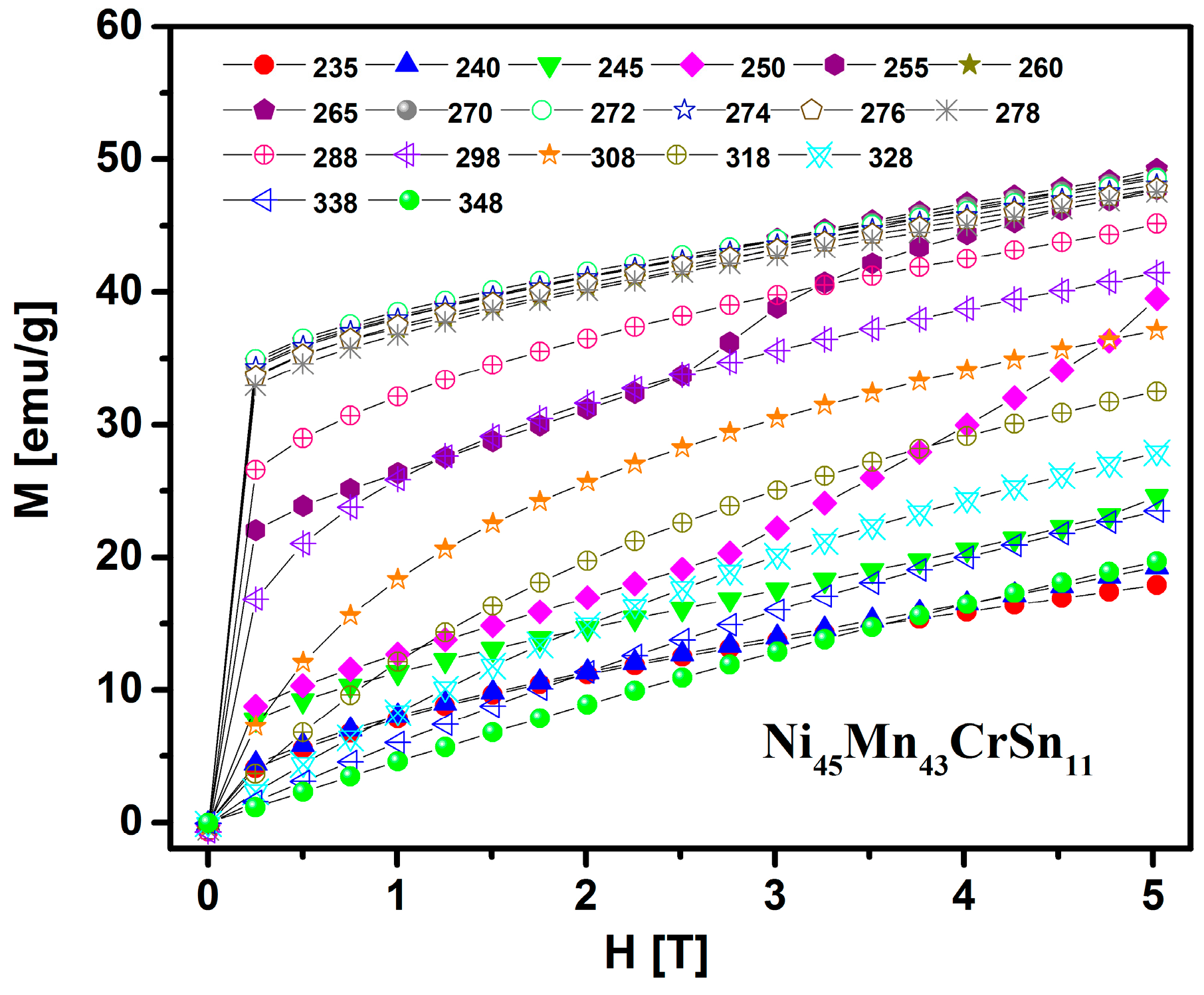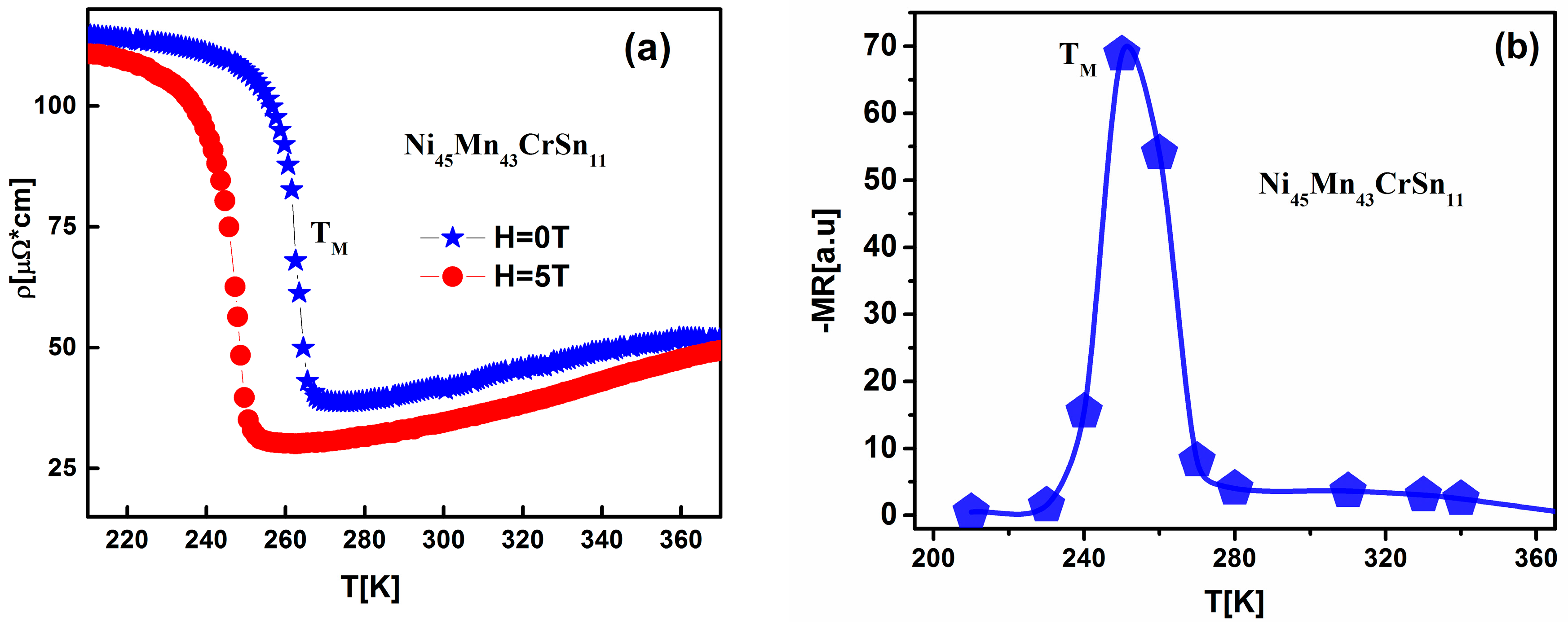Large Inverse Magnetocaloric Effects and Giant Magnetoresistance in Ni-Mn-Cr-Sn Heusler Alloys
Abstract
:1. Introduction
2. Results and Discussion
3. Materials and Methods
4. Conclusions
Acknowledgments
Author Contributions
Conflicts of Interest
References
- Glanz, J. Making a bigger chill with magnets. Science 1998, 279, 2045. [Google Scholar] [CrossRef]
- Tegus, O.; Bruck, E.; Buschow, K.H.; de Boer, F.R. Transition-metal-based magnetic refrigerants for room-temperature applications. Nature (London) 2002, 415, 150–152. [Google Scholar] [CrossRef] [PubMed]
- Provenzano, V.; Shapiro, A.J.; Shull, R.D. Reduction of hysteresis losses in the magnetic refrigerant Gd5Ge2Si2 by the addition of iron. Nature (London) 2004, 429, 853–857. [Google Scholar] [CrossRef] [PubMed]
- Brown, G.V. Magnetic heat pumping near room temperature. J. Appl. Phys. Lett. 1976, 47, 3673–3680. [Google Scholar] [CrossRef]
- Mazet, T.; Ihou-Mouko, H.; Malam, B. Mn3Sn: A promising material for magnetic refrigeration. Appl. Phys. Lett. 2006, 89, 0222503. [Google Scholar] [CrossRef]
- Zhang, X.; Zhang, B.; Yu, S.; Liu, Z.; Xu, W.; Liu, G.; Chen, J.; Cao, Z.; Wu, G. Combined giant inverse and normal magnetocaloric effect for room-temperature magnetic cooling. Phys. Rev. B 2007, 76, 132403. [Google Scholar] [CrossRef]
- Moya, X.; Mañosa, L.; Planes, A.; Aksoy, S.; Acet, M.; Wassermann, E.F.; Krenke, T. Cooling and heating by adiabatic magnetization in the Ni50Mn34In16 magnetic shape-memory alloy. Phys. Rev. B 2007, 75, 184412. [Google Scholar] [CrossRef]
- Pandey, S.; Quetz, A.; Aryal, A.; Samanta, T.; Dubenko, I.; Stadler, S.; Ali, N. Magnetic, transport, and magnetocaloric properties of boron doped Ni-Mn-In alloys. J. Appl. Phys. 2015, 117, 183905. [Google Scholar] [CrossRef]
- Pathak, A.K.; Khan, M.; Gautam, B.R.; Stadler, S.; Dubenko, I.; Ali, N. Exchange bias in bulk Ni-Mn-In-based Heusler alloys. J. Magn. Magn. Mat. 2009, 321, 963–965. [Google Scholar] [CrossRef]
- Dubenko, I.; Khan, M.; Pathak, A.K.; Gautam, B.R.; Stadler, S.; Ali, N. Magnetocaloric effects in Ni-Mn-X based Heusler alloys with X = Ga, Sb, In. J. Magn. Magn. Mat. 2009, 321, 754–757. [Google Scholar] [CrossRef]
- Khan, M.; Pathak, A.K.; Paudel, M.R.; Dubenko, I.; Stadler, S.; Ali, N. Magnetoresistance and field-induced structural transitions in Ni50Mn50−xSnx Heusler alloys. J. Magn. Magn. Mater. 2008, 320, L21. [Google Scholar] [CrossRef]
- Yu, S.Y.; Liu, Z.H.; Liu, G.D.; Chen, J.L.; Cao, Z.X.; Wu, G.H.; Zhang, B.; Zhang, X.X. Large magnetoresistance in single-crystalline Ni50Mn50−xInx alloys(x = 14–16) upon martensitic transformation. Appl. Phys. Lett. 2006, 89, 162503. [Google Scholar] [CrossRef]
- Pandey, S.; Quetz, A.; Aryal, A.; Samanta, T.; Dubenko, I.; Stadler, S.; Ali, N. The effects of substituting Ag for In on the magnetoresistance and magnetocaloric properties of Ni-Mn-In Heusler alloys. AIP Adv. 2016, 6, 056213. [Google Scholar] [CrossRef]
- Dubenko, I.; Quetz, A.; Pandey, S.; Aryal, A.; Eubank, M.; Rodionov, I.; Prudnikov, V.; Granovsky, A.; Lahderanta, E.; Samanta, T.; et al. Multifunctional properties related to magnetostructural transitions in ternary and quaternary Heusler alloys. J. Magn. Magn. Mater. 2015, 383, 186–189. [Google Scholar] [CrossRef]
- Quetz, A.; Koshkidko, Y.; Titov, I.; Rodionov, I.; Pandey, S.; Aryal, A.; Ibarra-Gaytan, P.J.; Prudnikov, V.; Granovsky, A.; Dubenko, I.; et al. Giant reversible inverse magnetocaloric effects in Ni50Mn35In15 Heusler alloys. J. Alloy. Compd. 2016, 683, 139–142. [Google Scholar] [CrossRef]
- Han, Z.; Wang, D.H.; Qian, B.; Feng, J.; Jiang, X.; Du, Y. Phase transitions, magnetocaloric effect and magnetoresistance in Ni-Co-Mn-Sn ferromagnetic shape memory alloy. Jpn. J. Appl. Phys. 2010, 49, 0211. [Google Scholar] [CrossRef]
- Wang, D.H.; Zhang, C.L.; Xuan, H.C.; Han, Z.D.; Zhang, J.R.; Tang, S.L.; Gu, B.X.; Du, Y.W. The study of low-field positive and negative magnetic entropy changes in Ni43Mn46−xCuxSn11 alloys. J. Appl. Phys. 2007, 102, 013909. [Google Scholar] [CrossRef]
- Chen, X.; Naik, V.B.; Mahendiran, R.; Ramanujan, R.V. Optimization of Ni-Co-Mn-Sn Heusler alloy composition for near room temperature magnetic cooling. J. Alloy. Compd. 2016, 618, 187–191. [Google Scholar] [CrossRef]
- Dan, N.H.; Duc, N.H.; Yen, N.H.; Thanh, P.T.; Bau, L.V.; Bang, N.A.; Mai, N.T.; Anh, P.K.; Thanh, T.D.; Phan, T.L.; et al. Magnetic properties and magnetocaloric effect in Ni–Mn–Sn alloys. J. Magn. Magn. Mater. 2015, 374, 372–375. [Google Scholar] [CrossRef]
- Sutou, Y.V.; Imano, Y.; Koeda, N.; Omori, T.; Kainuma, R.; Ishida, K.; Olikawa, K. Magnetic and martensitic transformations of NiMnX (X = In, Sn, Sb) ferromagnetic shape memory alloys. Appl. Phys. Lett. 2004, 85, 4358–4360. [Google Scholar] [CrossRef]
- Krenke, T.; Duman, E.; Acet, M.; Wassermann, E.F.; Moya, X.; Mañosa, L.; Planes, A.; Suard, E.; Ouladdiaf, B. Magnetic super elasticity and inverse magnetocaloric effect in NiMnIn. Phys. Rev. B 2007, 75, 104414. [Google Scholar] [CrossRef]
- Khan, M.; Dubenko, I.; Stadler, S.; Ali, N. Exchange bias in bulk Mn rich Ni-Mn-Sn Heusler alloys. J. Appl. Phys. 2007, 102, 113914. [Google Scholar] [CrossRef]
- Tishin, A.M.; Spichkin, Y.I. The Magnetocaloric Effects and Its Applications; IOP Publishing Ltd: Bristol, UK, 2003. [Google Scholar]






© 2017 by the authors. Licensee MDPI, Basel, Switzerland. This article is an open access article distributed under the terms and conditions of the Creative Commons Attribution (CC BY) license ( http://creativecommons.org/licenses/by/4.0/).
Share and Cite
Pandey, S.; Quetz, A.; Aryal, A.; Dubenko, I.; Mazumdar, D.; Stadler, S.; Ali, N. Large Inverse Magnetocaloric Effects and Giant Magnetoresistance in Ni-Mn-Cr-Sn Heusler Alloys. Magnetochemistry 2017, 3, 3. https://doi.org/10.3390/magnetochemistry3010003
Pandey S, Quetz A, Aryal A, Dubenko I, Mazumdar D, Stadler S, Ali N. Large Inverse Magnetocaloric Effects and Giant Magnetoresistance in Ni-Mn-Cr-Sn Heusler Alloys. Magnetochemistry. 2017; 3(1):3. https://doi.org/10.3390/magnetochemistry3010003
Chicago/Turabian StylePandey, Sudip, Abdiel Quetz, Anil Aryal, Igor Dubenko, Dipanjan Mazumdar, Shane Stadler, and Naushad Ali. 2017. "Large Inverse Magnetocaloric Effects and Giant Magnetoresistance in Ni-Mn-Cr-Sn Heusler Alloys" Magnetochemistry 3, no. 1: 3. https://doi.org/10.3390/magnetochemistry3010003




